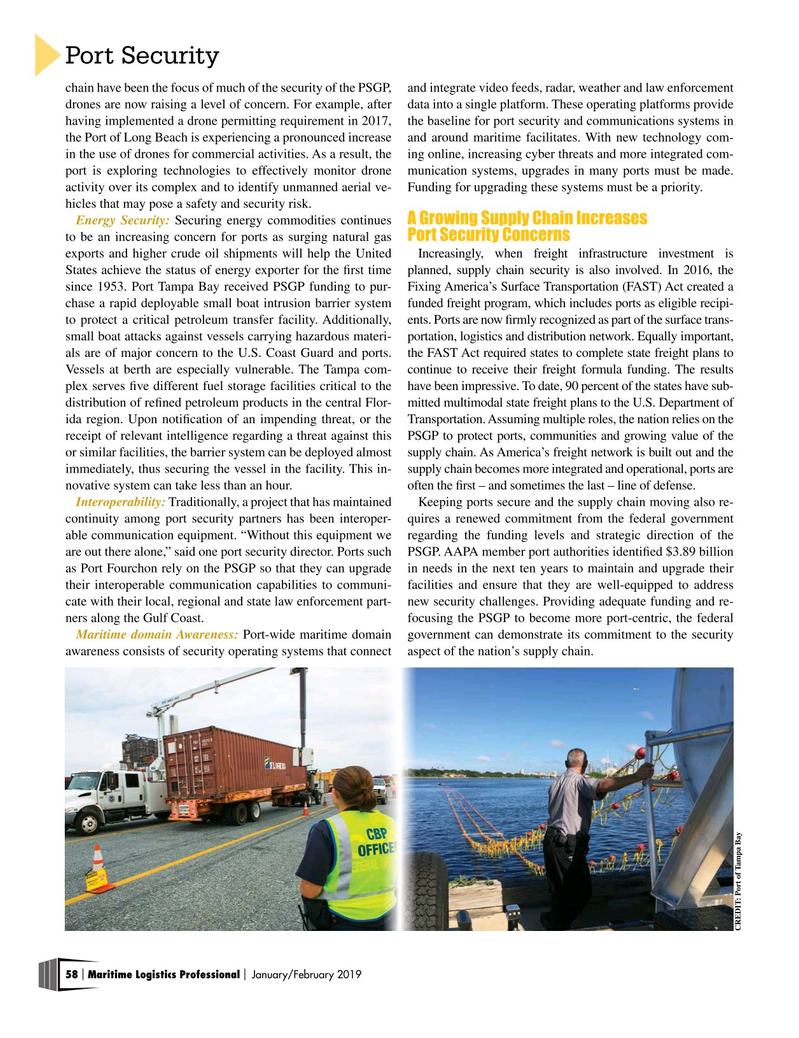
Page 58: of Maritime Logistics Professional Magazine (Jan/Feb 2019)
Cruise Ports Annual
Read this page in Pdf, Flash or Html5 edition of Jan/Feb 2019 Maritime Logistics Professional Magazine
Port Security chain have been the focus of much of the security of the PSGP, and integrate video feeds, radar, weather and law enforcement drones are now raising a level of concern. For example, after data into a single platform. These operating platforms provide having implemented a drone permitting requirement in 2017, the baseline for port security and communications systems in the Port of Long Beach is experiencing a pronounced increase and around maritime facilitates. With new technology com- in the use of drones for commercial activities. As a result, the ing online, increasing cyber threats and more integrated com- port is exploring technologies to effectively monitor drone munication systems, upgrades in many ports must be made. activity over its complex and to identify unmanned aerial ve- Funding for upgrading these systems must be a priority.
hicles that may pose a safety and security risk.
Energy Security: Securing energy commodities continues A growing Supply Chain Increases to be an increasing concern for ports as surging natural gas
Port Security Concerns exports and higher crude oil shipments will help the United Increasingly, when freight infrastructure investment is
States achieve the status of energy exporter for the frst time planned, supply chain security is also involved. In 2016, the since 1953. Port Tampa Bay received PSGP funding to pur- Fixing America’s Surface Transportation (FAST) Act created a chase a rapid deployable small boat intrusion barrier system funded freight program, which includes ports as eligible recipi- to protect a critical petroleum transfer facility. Additionally, ents. Ports are now frmly recognized as part of the surface trans- small boat attacks against vessels carrying hazardous materi- portation, logistics and distribution network. Equally important, als are of major concern to the U.S. Coast Guard and ports. the FAST Act required states to complete state freight plans to
Vessels at berth are especially vulnerable. The Tampa com- continue to receive their freight formula funding. The results plex serves fve different fuel storage facilities critical to the have been impressive. To date, 90 percent of the states have sub- distribution of refned petroleum products in the central Flor- mitted multimodal state freight plans to the U.S. Department of ida region. Upon notifcation of an impending threat, or the Transportation. Assuming multiple roles, the nation relies on the receipt of relevant intelligence regarding a threat against this PSGP to protect ports, communities and growing value of the or similar facilities, the barrier system can be deployed almost supply chain. As America’s freight network is built out and the immediately, thus securing the vessel in the facility. This in- supply chain becomes more integrated and operational, ports are novative system can take less than an hour. often the frst – and sometimes the last – line of defense.
Interoperability: Traditionally, a project that has maintained Keeping ports secure and the supply chain moving also re- continuity among port security partners has been interoper- quires a renewed commitment from the federal government able communication equipment. “Without this equipment we regarding the funding levels and strategic direction of the are out there alone,” said one port security director. Ports such PSGP. AAPA member port authorities identifed $3.89 billion as Port Fourchon rely on the PSGP so that they can upgrade in needs in the next ten years to maintain and upgrade their their interoperable communication capabilities to communi- facilities and ensure that they are well-equipped to address cate with their local, regional and state law enforcement part- new security challenges. Providing adequate funding and re- ners along the Gulf Coast. focusing the PSGP to become more port-centric, the federal
Maritime domain Awareness: Port-wide maritime domain government can demonstrate its commitment to the security awareness consists of security operating systems that connect aspect of the nation’s supply chain.
CREDIT: Port of Tampa Bay 58 Maritime Logistics Professional January/February 2019 | |

 57
57

 59
59
